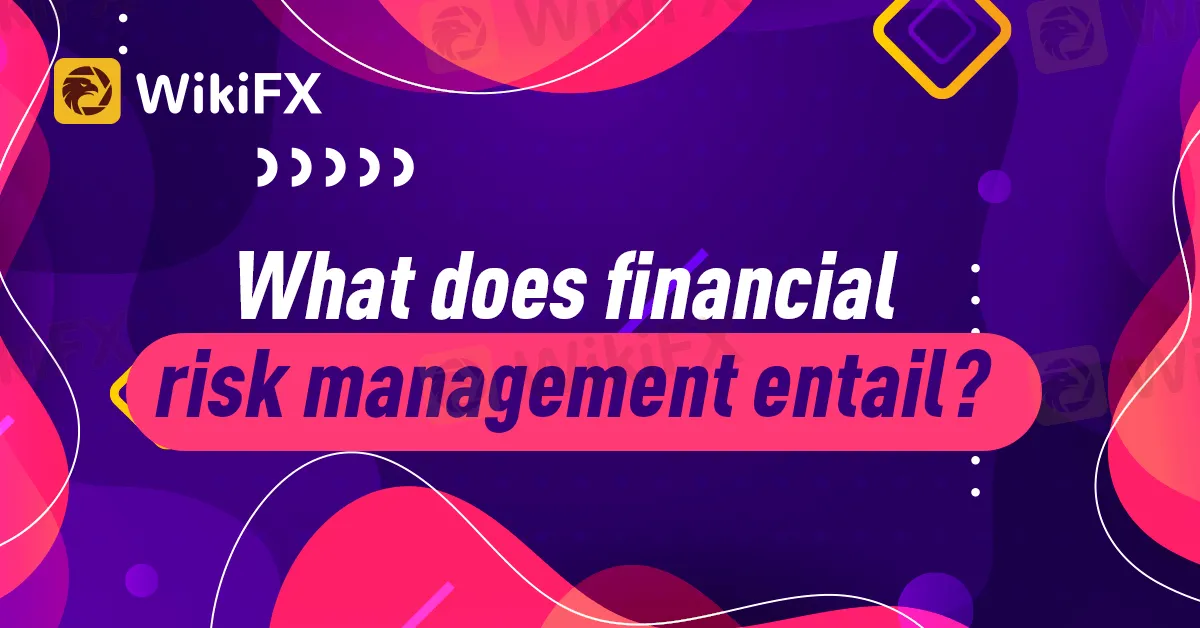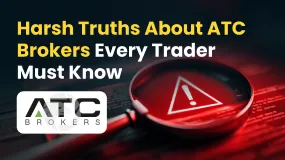简体中文
繁體中文
English
Pусский
日本語
ภาษาไทย
Tiếng Việt
Bahasa Indonesia
Español
हिन्दी
Filippiiniläinen
Français
Deutsch
Português
Türkçe
한국어
العربية
What does financial risk management entail?
Abstract:Before understanding the risks involved in the finance industry, the first thing you need to understand is that brokers scam their clients. This is a common and illegal practice on the part of brokers. It is important to find a broker that does not scam you. WikiFX makes it easy to find the best broker that will not be scamming you. WikiFX anylses the brokers so that you dont have to. They are making a difference in scamming brokers.

Before understanding the risks involved in the finance industry, the first thing you need to understand is that brokers scam their clients. This is a common and illegal practice on the part of brokers. It is important to find a broker that does not scam you. WikiFX makes it easy to find the best broker that will not be scamming you. WikiFX anylses the brokers so that you dont have to. They are making a difference in scamming brokers.
In the financial sector, risk management is the procedure for determining, assessing, and minimizing the risks of investment losses. When the market swings against our expectations, there is a chance of losing money. The risk mood of investors, which is impacted by a number of factors, shapes the patterns. These elements typically consist of commercial events like new technology, economic events like interest rate choices, or political events like elections.
Risk management is crucial for traders.
By using risk management, we may reduce losses if, following an incident, the market turns against us. All traders are tempted to seize any opportunity, but in order to be able to withstand a bad investment, we need to be aware of the hazards up front. A thorough forex risk management strategy and trading plan enable us to have a reliable source of income, as all successful traders are aware of and acknowledge that trading is a difficult process.
Trading Strategy and Risk Control
The caliber of their trading strategy and risk management plan for forex is what sets successful traders apart from those that fail. An effective trading strategy overview contains:
What to do when the markets turn against us, how to handle our emotions when trading, what precautions to take to ensure we will follow this plan, which financial instruments to focus on, when to enter and exit trades, where to set our profit and loss limits, how to determine useful or useless opportunities, what to do when the markets turn against us, how to deal with our emotions when trading.
Why is long-term Forex risk management so crucial?
In that they provide a variety of trading options with the potential to generate sizable returns fast yet need a sizable initial investment, forex markets are alluring. Most traders quickly realize, though, that this strategy is unsustainable, and after a few transactions, a single loss can completely deplete the portfolio. Implementing a planned and comprehensive
The Process of Risk Management
Risk is the possibility that the actual ROI may differ from the anticipated ROI. The variances, which change in direction and size owing to trade-related events, occur. A favorable incident can cause a positive deviation, bringing in more money than we anticipated. Negative deviation can result from unfavorable situations and indicate earning less than anticipated, breaking even, or suffering a loss. The trading volume is impacted by each market-influencing event component in terms of position frequency, magnitude, and direction, which results in a variation in the speed and severity of price changes.
Volatility is the term for this. Risk tolerance is based on our ability to bear significant volatility psychologically and financially. Our potential returns will increase as our risk tolerance rises. We require a risk management plan in order to comprehend our risk appetite and formulate a strategy appropriately. Three crucial elements make up the risk management process: detection, appraisal, and mitigation. Below is an example of a risk management plan.
Identification: How Can Financial Risk Be Spotted?
Understanding the many factors at play is necessary to recognize financial dangers. Typical market-wide effects on all industries are caused by fundamental economic issues like interest rate choices and trade conflicts. The confidence of investors and consumers is impacted by ancillary economic elements like economic reports, which also change short- and medium-term trends. Quarterly earnings reports, for example, provide information on certain sectors or financial assets. Despite having a small effect area, they have the ability to shift the target assets dramatically.
Although there is a great variety of information, not all of it is important to us. We should first include the economic events that could have an impact on our assets in our trading plan. Then, we should take notice of their qualities in terms of their ability to cause price fluctuations, how frequently they are released, and the variables that can have an impact on the statistics in these reports. We might reduce the noise and concentrate on the important news if we defined the range of information to monitor. The likely outcomes for each report should then be discussed, along with whether they would be favorable or unfavorable for our investment. By differentiating the dangerous situations, we can choose the relevant market signals and get ready for any problems our portfolio may encounter.

Evaluation: How Should Trading Risks Be Assessed?
Different trading risk categories may be evaluated using a variety of techniques. The management of active risks and passive risks is one of the most often used risk appraisal approaches. Passive risks are those that result from an investment's exposure to market events, whereas active risks are those that result from the trading technique used in the portfolio.
Risk and Alpha Active
Active risks are the risks resulting from our trading strategy and may be thought of as the subjective risk exposure.
The active risk ratio, or alpha, gauges how well an asset performs over time in comparison to a benchmark. A positive alpha suggests a larger return percentage than the benchmark when zero is used as the baseline, whereas a negative alpha indicates a lower return. For instance, if we compare the 30-day alpha for Facebook (NASDAQ: FB) to the Nasdaq100 index and find it is 3%, it signifies that during that time, Facebook had a 3% better return on investment than the NASDAQ-100.
Beta and Passive Risk
Passive risks are the risks resulting from market occurrences that are beyond our control and may be thought of as objective risk exposure.
The passive risk ratio known as beta gauges an asset's volatility over time in comparison to a benchmark. Using 1 as a reference point, a beta value greater than 1 denotes more asset price volatility than the benchmark price, and a beta value less than 1 denotes reduced volatility. An investment in this stock would have a better potential return but also a higher chance of loss than its benchmark if its beta was higher. On the other side, a smaller beta would indicate reduced risk and possible return. The stock beta would be 0.5 larger than the benchmark beta, for instance, if we calculate the beta for the Coca-Cola Company (NYSE: KO) versus the Dow30 (INDEXDJX: DJI) index and obtain 1.5.
Alpha () and Beta (ß) Calculation
The following are the calculation formulae for alpha () and beta (ß):
Alpha () is equal to Rp - [Rf + ß(Rm - Rf)]
Beta (ß) is defined as Covariance (Re, Rm) / Variance (Rm)
Rp: Return Percentage of the Portfolio - Return Percentage of the Portfolio for the Selected Period
Rm: Return of the market minus the benchmark's percentage return for the selected time period
Return of the risk-free trade - the return percentage of an investment with low risk
Re: Return of the equity - the stock's return percentage over the selected time
For instance, we want to know how much risk we are exposed to while trading Microsoft stocks in Q4 using the NASDAQ 100 index as a benchmark. During this period, say,
The portfolio's return (Rp) was 15%, the NASDAQ 100 index's return (Rm) was 10%, the return on the 3-Month U.S. Treasury Note (Rf) was 1%, and the return on Microsoft (Re) was 12%.
We begin with ß first since alpha requires beta, so we do that first. Let's assume that within the time frame, there is a 0.9 (90%) price correlation between Microsoft and the NASDAQ 100 and a 1.35% price variance.
We calculate the covariance of the stock and the market, then divide to the market return, and find ß = 0.67 (67%). Next, we use ß to calculate alpha. We insert the numbers to the formula and find α = 7.97%.
By interpreting our = 7.97% and ß = 0.67 figures, we get to the conclusion that Microsoft outperformed the benchmark NASDAQ 100 index over the specified time period by providing a 7.97% higher risk-adjusted return and suffering 33% less volatility.

Application of Alpha and Beta in Real Life
We determine the alpha and beta values based on the historical performance of a financial instrument and a benchmark over time. Then, we make predictions based on this data about future active and passive risk exposure over a comparable time span. If Apple introduced a new iPhone model, what would happen to Apple shares during the following three months? To calculate the risk exposure of trading Apple, we examine the performance over the past three months after the release of a product.
The alpha and beta values are calculated using the NASDAQ-100 index as a reference. We may learn about the active and passive risks in the following three months by looking at the alpha and beta numbers for the three months after the prior launch. We may enhance our alpha and beta risk analysis in a number of ways, such by setting a confidence interval, utilizing several benchmarks, and averaging multiple timeframes.
Different Timeframes
The aforementioned example only uses the prior product launch. We may utilize the most recent three launches to enhance our estimation. We first figure out each's alpha and beta. The averaged alpha and beta are then discovered. However, we have to remember that market circumstances might have varied depending on the time period. Weighted alpha and weighted beta calculations are often used by analysts.
Assurance Interval
By measuring the standard deviation (SD) of the alpha and beta values and establishing a confidence interval, we may enhance several periods. As a consequence, we can predict that the outcome will be within one positive SD and one negative SD with a 67% confidence level. Additionally, we can predict the outcome with 95% confidence to be between two negative SD and two positive SD. The alpha value for the upcoming three months may be predicted with 67% confidence to be between 3.5% and 4.5%, and with 95% confidence to be between 3% and 5%, for instance, if the average alpha is 4% and the standard deviation is 0.5%.
Strategies for Risk Management as Mitigation
Knowing how to distinguish and assess
Budget-Based Risk Management Techniques
Budget-based methods incorporate financial management techniques. We create a capital distribution strategy that specifies how we deploy our assets across all investments in accordance with our resources, leverage, and trading objectives. It also offers investing exit methods, price goals, and position size guidelines.
Size of Position
The term “position sizing” describes the proportion of the size of one position to the entire capital. The 1% rule, which states that a position's size should never exceed 1% of total capital, is followed by successful traders. For instance, if you have $10,000 in capital, your allocated margin for a position should be no more than $100. The leftover capital protects you against a close-out and acts as a cushion against fluctuating profits and losses (P/L). The risk variables and volatility levels fluctuate for each asset. Thus, by appropriately altering your position sizing technique, you can balance the investment and the risk.
Ratio P/L
The victory percentage of your closed trades is known as the P/L Ratio. Since the final determinant of your performance will be the real earnings, a high P/L ratio does not necessarily signal portfolio profitability. We should develop a reward/risk ratio in order to comprehend the necessary P/L ratio (RRR). For instance, if our RRR is 3:1, our victory rate must be 25%. However, since the RRR is 1:1, a 50% victory rate is required. There are various online calculators available to determine the necessary P/L ratio depending on RRR.
Price Objectives
It may be emphasized that one of the most essential risk control tactics is understanding when to abandon a position as well as when to initiate it. Keeping a profitable position open might help you accrue gains.
10 Risk Management Guidelines
Any trading plan's most crucial component is risk control. There are various measures you may take as a trader and take into consideration throughout your decision-making process in addition to the quantitative and strategic techniques to use.
Never take a risk you can't afford to take.
Rule No. 1: Never forget.
Follow your trading strategy.
Think about the fees associated with spread, rollover/swap, and commissions.
To prevent margin calls, keep track of your available margin and keep your usage to a minimum.
Use take profit and stop loss orders at all times.
Never leave unattended open positions.
Keep a performance log and make adjustments as you advance.
Avoid volatile times, such as those around economic news releases.
When trading, try to keep your emotions out of it.
Do not forget to download the WifiFX app on the app store and play store.

Disclaimer:
The views in this article only represent the author's personal views, and do not constitute investment advice on this platform. This platform does not guarantee the accuracy, completeness and timeliness of the information in the article, and will not be liable for any loss caused by the use of or reliance on the information in the article.
Read more

Harsh Truths About ATC Brokers Every Trader Must Know
Many regulated brokers hide the risks associated with them. They never talk about these risks and try to attract customers with appealing offers. Later on, customers discover these hidden risks and feel disappointed. Before you come across a similar situation, we want to let you know the risks involved with ATC Broker. Check out the article to discover the harsh truth about it.

8 Golden Rules to Rule in the Forex market
These are important rules that most people won’t tell you. Whether you’re new to Forex beginner or have been trading for a while, these tips can help improve your trading journey. Read this article to learn the key rules every trader should keep in mind.

5 Clear Reasons Why Ultima Markets Is Smart Investment?
The Right Investment is hard to find these days. The Forex market is full of scam brokers, and it's a tough task to find the trusted ones. However, you can check out this article to discover 5 specific reasons why Ultima Markets stands out as a reliable choice.

JAFX - Where Investors Face Withdrawal Issues & Unprofessional Behavior
Are you facing withdrawal issues with JAFX? Are its executives asking you to pay a fee to get withdrawals? Accepted withdrawals failing to hit your wallet? You are virtually scammed by the company. Explore this story containing a wide range of issues investors face at JAFX.
WikiFX Broker
Latest News
Alchemy Markets: A Closer Look at Its Licenses
Wondering Why Your International Earnings Come Less Than Expected? It's Because of Forex Markup Fees
FCA to modernise rules to unlock investment
How Fake News Sites Are Fueling a Global Investment Scam Epidemic
From Novice to Pro: Why Investors Trust Land Prime?
10-year Treasury yield ticks lower after core CPI comes in slightly lightly lower than expected
Asia-Pacific markets mixed after Trump's tariffs on Indonesia
Labubu craze to drive up profit 350%, China\s Pop Mart says
PrimeXBT Launches MT5 PRO Account for Active Traders
Central banks are increasingly buying gold from local mines as prices surge
Currency Calculator


